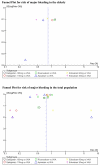Efficacy and Harms of Direct Oral Anticoagulants in the Elderly for Stroke Prevention in Atrial Fibrillation and Secondary Prevention of Venous Thromboembolism: Systematic Review and Meta-Analysis
- PMID: 25995317
- PMCID: PMC4765082
- DOI: 10.1161/CIRCULATIONAHA.114.013267
Efficacy and Harms of Direct Oral Anticoagulants in the Elderly for Stroke Prevention in Atrial Fibrillation and Secondary Prevention of Venous Thromboembolism: Systematic Review and Meta-Analysis
Abstract
Background: Evidence regarding the use of direct oral anticoagulants (DOACs) in the elderly, particularly bleeding risks, is unclear despite the presence of greater comorbidities, polypharmacy, and altered pharmacokinetics in this age group.
Methods and results: We performed a systematic review and meta-analysis of randomized trials of DOACs (dabigatran, apixaban, rivaroxaban, and edoxaban) for efficacy and bleeding outcomes in comparison with vitamin K antagonists (VKA) in elderly participants (aged ≥75 years) treated for acute venous thromboembolism or stroke prevention in atrial fibrillation. Nineteen studies were eligible for inclusion, but only 11 reported data specifically for elderly participants. The efficacy in managing thrombotic risks for each DOAC was similar or superior to VKA in elderly patients. A nonsignificantly higher risk of major bleeding than with VKA was observed with dabigatran 150 mg (odds ratio, 1.18; 95% confidence interval, 0.97-1.44) but not with the 110-mg dose. Significantly higher gastrointestinal bleeding risks with dabigatran 150 mg (1.78, 1.35-2.35) and dabigatran 110 mg (1.40, 1.04-1.90) and lower intracranial bleeding risks than VKA for dabigatran 150 mg (0.43, 0.26-0.72) and dabigatran 110 mg (0.36, 0.22-0.61) were also observed. A significantly lower major bleeding risk in comparison with VKA was observed for apixaban (0.63, 0.51-0.77), edoxaban 60 mg (0.81, 0.67-0.98), and 30 mg (0.46, 0.38-0.57), whereas rivaroxaban showed similar risks.
Conclusions: DOACs demonstrated at least equal efficacy to VKA in managing thrombotic risks in the elderly, but bleeding patterns were distinct. In particular, dabigatran was associated with a higher risk of gastrointestinal bleeding than VKA. Insufficient published data for apixaban, edoxaban, and rivaroxaban indicate that further work is needed to clarify the bleeding risks of these DOACs in the elderly.
Systematic review registration: http://www.crd.york.ac.uk/PROSPERO. Unique identifier: PROSPERO CRD42014007171/.
Keywords: aged; anticoagulants; atrial fibrillation; hemorrhage; meta-analysis; systematic review; venous thromboembolism.
© 2015 American Heart Association, Inc.
Figures






Comment in
-
ACP Journal Club: review: in older patients with AF or acute VTE, some DOACs reduce thrombotic events and major bleeding.Ann Intern Med. 2015 Nov 17;163(10):JC4. doi: 10.7326/ACPJC-2015-163-10-004. Ann Intern Med. 2015. PMID: 26571258 No abstract available.
References
-
- Lloyd-Jones DM, Wang TJ, Leip EP, Larson MG, Levy D, Vasan RS, D’Agostino RB, Massaro JM, Beiser A, Wolf PA, Benjamin EJ. Lifetime risk for development of atrial fibrillation: the Framingham Heart Study. Circulation. 2004;110:1042–6. - PubMed
-
- Kyrle PA, Eichinger S. Clinical scores to predict recurrence risk of venous thromboembolism. Thromb Haemost. 2012;108:1061–4. - PubMed
-
- Go AS, Hylek EM, Phillips KA, Chang Y, Henault LE, Selby JV, Singer DE. Prevalence of diagnosed atrial fibrillation in adults: national implications for rhythm management and stroke prevention: the Anticoagulation and Risk Factors in Atrial Fibrillation (ATRIA) Study. JAMA. 2001;285:2370–5. - PubMed
-
- Vidaillet H, Granada JF, Chyou Po-H, Maassen K, Ortiz M, Pulido JN, Sharma P, Smith PN, Hayes J. A population-based study of mortality among patients with atrial fibrillation or flutter. The American Journal of Medicine. 2002;113:365–70. - PubMed
-
- Anderson FA, Jr., Spencer FA. Risk factors for venous thromboembolism. Circulation. 2003;107:I9–16. - PubMed
Publication types
MeSH terms
Substances
Grants and funding
LinkOut - more resources
Full Text Sources
Other Literature Sources
Medical

